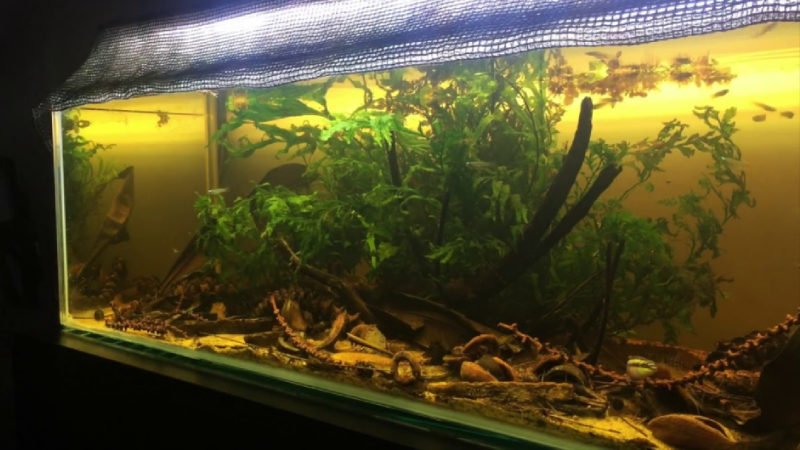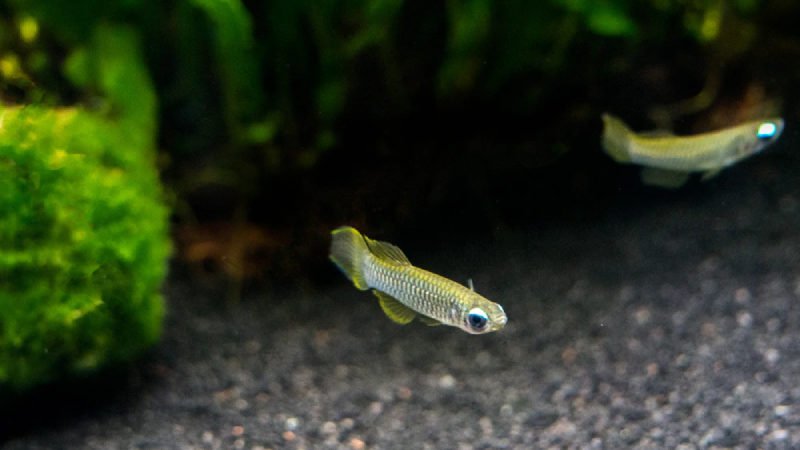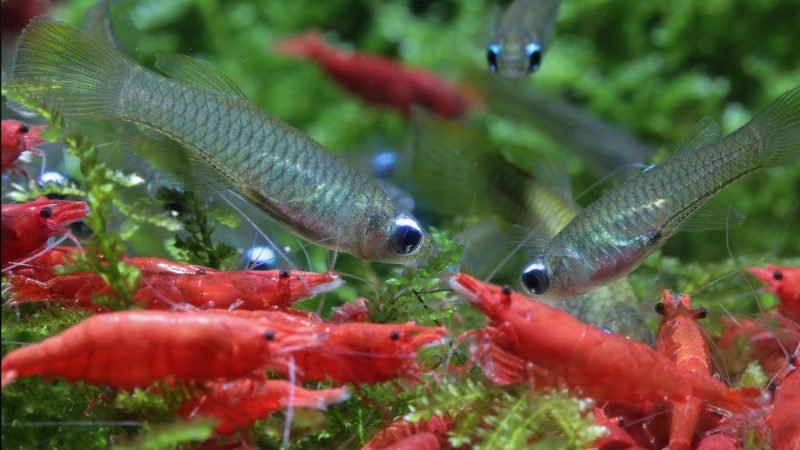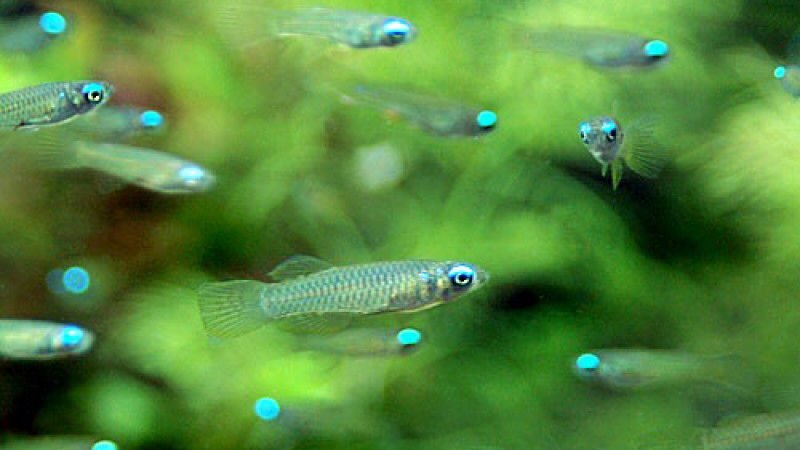The Lampeye could make a great addition to your community tank if you have been looking for the perfect tropical fish. Tropical fish are a very unique species, and their appearance and behavior are extremely unique, which adds a lot of excitement to your aquarium. Both beginners and intermediate aquarists will find these warm-water fish to be a great choice.
Additionally, it is also easy to take care of the fish and let them live peacefully with the rest of the others in the tank. This guide will provide you with further details about how to care for your fish, as well as specific tips for Lampeye killifish care.
Related Articles
- Lampeye Killifish With Shrimp: 3 Essential Factors To Keep Them Live Healthily
- Lampeye Killifish Breeding & Eggs: All Things That You Should Know
Lampeye Killifish Overview
- Level of care: Beginner–Intermediate
- Temperament: Peaceful
- Social behavior: Schooling
- Lifespan: 3 years
- Size: 1.2 – 1.6 inches (3 – 4 cm)
- Diet: Omnivore
- Family: Poeciliidae
- Minimum Tank Size: 20 gal
- Tank environment: simulate their natural habitat. A dark substrate
Lampeye Killifish: How To Care
I think the best way to take care of your little fish is to maintain the ideal water conditions and to ensure that the tank environment resembles their natural habitat as closely as possible.
Aquarium Setup

The Lampeye, like many other fish, will do best and display most effectively in a tank that is designed to simulate their natural environment. This is best achieved by using a dark substrate in an aquarium with plenty of light. Since they are a bit shy, plants can serve as hiding places for them, while leaving some open space for swimming.
There is a possibility these fish may dart right out of the tank when startled, so it is important to have a tight-fitting hood to keep them in. This species is easily startled, so setting your lights to a timer and turning on your moonlights before turning off your tank light is a good idea. Avoid turning on the tank when the room is too dark in the morning to avoid startling the fish.
Water Conditions
Preparing your tank is the first step. Before picking up your panchax fish from the market, did you have the water tested? These little fish are extremely sensitive to water conditions and fluctuations of the water. Water must be filtered to remove ammonia and nitrites.
When you have a brand new aquarium at home, if you want your Lampeye fish to thrive in it, we suggest it matures first so that it is ready to host the fish. To ensure that your fish are in the best possible health and condition, the heavily planted aquarium must also have a high-quality water supply.
Make sure to stick to these variables in order to maintain the quality of the water:
- Temperature: 72 – 79℉
- pH: 6.0–7.5
- Hardness: 18-215 ppm
Décoration
For a shoaling fish to thrive, it needs a lot of plants and dense vegetation as well as a slower water flow. A good aquarium characteristic would be a feature that mimics the habitat in which a particular species of fish naturally lives.

Since they are so small, they tend to be timid and afraid when they see others that are bigger (inside and outside the tank). This is why they require vegetation to be able to provide shade and cover to rest and hide in.
Many people claim they are hardy fish because they are easy to maintain. In reality, however, they are an extremely delicate type of fish that needs good water conditions to survive. Small changes in the water do not affect their health, but when nitrates and ammonia levels are high, they will suffer from health problems. It is recommended that you change the large portion of water in the tank at least once a week to maintain the water’s quality.
The community tank can also be covered with driftwood in addition to the dense plants. Additionally, if you would like to go that extra mile, you can also stick some tall plants in the driftwood.
Make sure that the water flow is slowed down as much as possible. If the current is too strong the fish will become more agitated to live.
In regards to the bottom part, you would want to consider using a substrate with a darker color tone. In the middle of the night, the dark-colored sand can provide the fish with a bit of contrast, making them visible, so they can be seen glowing in the middle of the night.
Lighting
The lighting should be dimmed in order to provide the fish with a calm and cool environment. In fact, the bright light can easily intimidate the fish and make them feel uncomfortable. The floating plants and dense vegetation will also be able to provide shade and dim the light to make the area more comfortable.
Lampeye Tank Mates
The Lampeye fish comes in a small size, so you may choose to pair it with other peaceful small fish like shrimps, tetras, and corydoras.

The Lampeye fish is not a lone wolf. In other words, you could add a group of at least ten specimens of the same Lampeye species. Lampeyes are social animals and they enjoy doing everything together.
In many cases, aquarists will also provide their Lampeye fish with a dedicated tank so that their maintenance and setup will be much better. Similarly, you may use this idea if you wish to keep your fish longer.
You do not need to keep a lonely aquascape, of course. It is possible to pair them with other species of small fish as well. You may also consider adding some other species, including pencilfish, boards, and other tiny anabantoids, in addition to those that I have mentioned already.
Avoid adding larger fish due to the possibility of them bullying your Lampeye fish.
How To Feed Lampeye
The Lampeye Killifish is primarily a carnivore. In the wild, they eat insect larvae, aquatic insects, and small invertebrates. The Killifish, however, require variations in their diets to maintain good health. When it comes to food, Lampeye tiny buddies do not seem to be too picky. It doesn’t matter what you add to their tank, they will take everything you add and they will be grateful for everything. If you want your fish to be healthy and well, you should only provide them with quality food.
Experts recommend adding tropical fish flakes to their diets. There are some treats you can give along with this diet to make it more interesting and interesting, such as brine shrimp, cyclops, mini bloodworms, mosquito larvae, etc.
Fish Diseases
In a properly maintained aquarium, Lampeye Killifish are actually quite hardy and do not usually suffer from disease problems. However, because health problems and diseases may arise at any time, you cannot be guaranteed that you will be free of them. A lack of good water quality will mainly result in velvet and bacterial infections if they are not properly cared for. A
nything that is added to your aquarium can bring with it diseases that are harmful to your fish. This includes not only other fish, but also plants, substrates, and decorations that can harbor bacteria. Make sure that you take great care and clean and quarantine anything that you add to a well-established tank in order to avoid upsetting the delicate balance that the tank has established.
A well-balanced diet and the right environment are the best ways to prevent disease in Banded Lampeyes. In my opinion, the closer to the natural habitat tank conditions are, the less stress they will experience and the healthier and happier they will be. Fish that are stressed are more likely to contract diseases.
Lampeye Killifish are very resilient, but you should learn about the common diseases in aquariums. It is extremely important to recognize the signs of the disease and to identify and treat it as early as possible.
Video: Lampeyes and Red Cherry Shrimps
FAQs
How to distinguish the Lampeye Killifish male and female?
There is a slight difficulty in distinguishing between male and female Norman’s Lampeye Killifish. Males tend to have longer fins and are a little bit more colorful, whereas females tend to have duller fins that are shorter and rounded. Males also tend to grow larger than females do.
Are killifish easy to keep?
The keeping of killifish varies from easy to difficult, depending on the species. There are a few things you need to keep in mind before buying killifish, but if you want to try something a little different, these fish are well worth the effort!
How many killifish should be kept together?
It is most beneficial to keep killifish together so that they can thrive. I recommend that at least three of them should be kept together (1 male and 2 females). If you have a tank that is larger (30+ gallons) then you can keep up to 12 individuals together.
What is Neon Stripe Lampeye Killifish?
This Neon Stripe Lampeye Killifish certainly lives up to its name as soon as you notice it. It has stunning blue eyes that are glistening on a silvery-white background with small splashes of color here and there; they are truly gorgeous. This fish’s fins have a yellowy red tint to them, varied in colour and opacity, although it is usually more subdued than spectacular. All of these features, together with its vivacious swimming style as well as their eye-catching coloration, make this fish an excellent addition to aquascapes.
The viewer’s eyes are forced to go all over the scene as they dart around the aquarium, and they are not distracted from the exhibit that they are there to emphasize as a result of their darting about. Ours are bred in the United States and are originally from Africa. They are now approximately 1 1/2 inch in length, and although they will not grow much longer they will get girthier and much brighter after they have acclimated to your tank.
Originally, these fish were taken from a variety of rivers in Central and West Africa, with various species of the same genus being collected from various regional rivers across Africa. These killis, which are native to Africa’s rivers, like water that is somewhat acidic and low in hardness. Neon Stripe Lampeye Killifish are small savannah fish that live in shallow water. Therefore, when it comes to temperature, these normani killifish seem to be able to handle temperatures between 65 and 80 degrees Celsius, which is a broad temperature range compared to many other species that we maintain in our tanks.
Conclusion
Lampeye killifish is a very peaceful killifish that is perfect for both beginners as well as expert level aquarium keepers, and it makes a great addition to the planted aquarium as well.
Taking care of them is not too easy, but not difficult. The beauty that they will bring to your aquarium tank deserves your care. I hope this article has helped you.

Annette M. Chaney is an experienced marine biologist with over 20 years of experience as an aquarist and fishkeeper. She started her first aquarium at a young age, filling it with frogs and goldfish obtained from the ten-cent pet store.
Annette grew up caring for and breeding African Cichlids, which led to a hobby in high school that doubled as a profitable means. Attending Reed College gave her time to solidify herself as an accomplished aquarium caretaker with an eye for sales. After that, from 2009 – 2013, she studied at Roger Williams University – one of the most prestigious universities for Aquaculture and Aquarium in USA. She is the founder of AquariumCircle since 2010.
